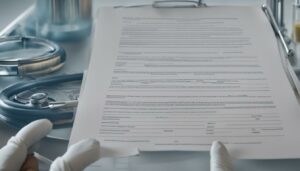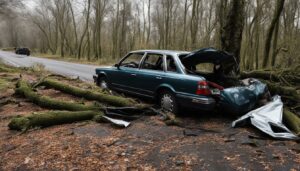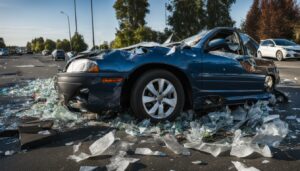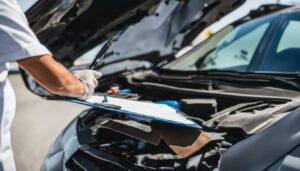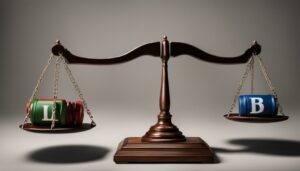Have you ever wondered if you’re always to blame for a single-car accident? The answer might surprise you. While it’s often assumed that the driver is at fault in these situations, there are exceptions to this rule. Understanding the factors that determine fault in a single-car accident is crucial for protecting your rights and potentially disputing a fault finding.
Key Takeaways
- A single-car accident doesn’t always mean the driver is automatically at fault.
- Understanding the underlying cause of the accident is essential for determining liability.
- If you believe you’re not at fault, gather evidence and consider disputing the fault finding.
- Insurance companies and police reports play a significant role in determining fault.
- Seeking legal help can be beneficial if you need to dispute fault and protect your rights.
What Constitutes a Single-Vehicle Accident?
A single-vehicle accident is defined as an incident involving only one car, truck, or motor vehicle. It occurs when the driver loses control of the vehicle, collides with an object on the road, or swerves to avoid something. Understanding the causes and examples of single vehicle accidents is crucial to determining fault and liability.
Causes of single vehicle accidents can vary widely. Some common examples include colliding with a guardrail or median, running off the road to avoid a pedestrian or animal, rolling over due to loss of control, or striking a stationary object. These accidents usually don’t involve other vehicles, but they can still result in significant damage or injuries.
Here is an illustrative table showing some common causes and examples of single vehicle accidents:
“A single-vehicle accident involves only one car, truck, or motor vehicle. It can occur when the driver hits an object on the road, swerves to avoid something, or loses control of the vehicle.”
Definition of Single-Vehicle Accident
In summary, a single-vehicle accident refers to an incident where only one motor vehicle is involved. It can happen when the driver loses control, collides with an object, or takes evasive action. By understanding the definition and examples of single vehicle accidents, individuals can better navigate fault and liability in such situations.
Liability in a Single Car Accident
When it comes to liability in a single car accident, the driver is often assumed to be at fault. However, it’s important to understand that there are exceptions to this general rule. While the driver is typically held responsible, there are scenarios where blame may lie elsewhere.
If you find yourself at fault in a single vehicle accident, you may still be able to make a car insurance claim depending on your coverage. Personal injury protection, collision coverage, and health insurance may cover certain expenses. However, it’s important to note that not all damages may be recoverable. Each case is unique, and the specific circumstances of the accident will determine the outcome.
It’s crucial to gather evidence and dispute a fault finding if you believe the accident was not your fault. Insurance companies rely on various factors when determining liability, such as police reports, witness statements, and the evaluation of the accident scene. If you have evidence supporting your claim that the accident was caused by external factors beyond your control, such as poor road conditions or a vehicle defect, it’s important to present this information to your insurance company and seek legal advice if necessary.
Determining Fault in a Single Car Accident
Determining fault in a single car accident can be a complex process. While the driver is often presumed to be at fault, it’s not always the case. Various factors can contribute to the accident, including external circumstances or vehicle malfunctions. To navigate the process successfully, it’s important to gather all available evidence, such as police reports, witness statements, and any photographic documentation of the scene.
Insurance companies play a significant role in determining fault in single car accidents. They rely on the evidence presented and conduct their own investigations to analyze liability. If there is a dispute between parties regarding fault, the case may be taken to court, where a jury can make the final determination. Seeking legal assistance from a car accident lawyer can help ensure that your rights are protected throughout the process and increase your chances of a favorable outcome.
When the Driver in a Single Vehicle Accident is Not Liable
In some cases, the driver in a single-vehicle accident may not be liable for the incident. There are several situations where the driver can avoid blame and be considered not at fault.
One such scenario is when the accident occurs while trying to avoid a negligent driver. If the driver takes evasive action to avoid a collision with another vehicle that is being operated in a careless or reckless manner, they may not be held responsible for the resulting accident.
Another situation where the driver may not be liable is when the accident is caused by unreasonably unsafe road conditions. Poorly maintained roads, inadequate signage, or hazardous obstacles on the roadway can contribute to a single-vehicle accident. In these cases, the driver can argue that the condition of the road was the cause of the accident, and therefore, they should not be held responsible.
Finally, a driver may escape liability if a vehicle defect played a part in causing the accident. Malfunctioning brakes, faulty steering, or other mechanical failures can contribute to a single-vehicle accident. If it can be proven that the accident was a result of a defect in the vehicle, the driver may not be considered at fault.
Table: Situations where the driver may not be liable in a single-vehicle accident
| Situation | Explanation |
|---|---|
| Avoiding a negligent driver | If the driver takes evasive action to avoid a collision with a vehicle operated in a careless or reckless manner, they may not be held responsible. |
| Unreasonably unsafe road conditions | Poorly maintained roads, inadequate signage, or hazardous obstacles on the roadway can contribute to a single-vehicle accident. In these cases, the driver can argue that the condition of the road was the cause of the accident. |
| Vehicle defect | If a vehicle defect, such as malfunctioning brakes or faulty steering, played a part in causing the accident, the driver may not be considered at fault. |
It’s important to note that determining liability in a single-vehicle accident can be complex, and each case is unique. If you believe you are not at fault for the accident, it is advisable to consult with a qualified car accident lawyer who can assess the details of your case and provide guidance on how to proceed.
How to Defend Yourself in a Single-Vehicle Accident
When involved in a single-vehicle accident, it is crucial to gather evidence to support your case if you believe you are not at fault. Disputing fault in a single car accident requires concrete proof to challenge the initial finding. Here are some steps you can take to defend yourself:
- Report the accident to your car insurance carrier: Notify your insurance company promptly and provide them with all the necessary details about the accident. This will initiate the claims process and allow them to investigate further.
- Collect witness information: If there were any witnesses to the accident, gather their contact information. Witness testimonies can provide valuable evidence to support your claim and challenge the initial fault determination.
- Gather photographic evidence: Take photos of the accident scene, vehicle damage, and any contributing factors such as road conditions or obstructions. Visual evidence can help demonstrate that external factors or hazards played a significant role in the accident.
- Have your vehicle inspected by a qualified mechanic: If you suspect a mechanical defect or malfunction contributed to the accident, have your vehicle thoroughly examined by a professional. A detailed inspection report can help strengthen your case and prove that the accident was not solely your fault.
By following these steps and gathering compelling evidence, you can present a strong defense in disputing fault in a single-car accident. It is important to consult with a qualified car accident lawyer who can guide you through the process and advocate for your rights.
Image source: SEO Writing
The Role of Police Reports in Determining Fault
When it comes to determining fault in car accidents, police reports play a crucial role. These reports provide an objective and detailed account of the accident, which insurance companies often rely on to determine liability. The importance of police reports cannot be overstated, as they contain vital information that can significantly impact the outcome of a claim or lawsuit.
The police report includes essential details such as the date, time, and location of the accident, as well as a description of the vehicles involved, their damages, and any injuries sustained. It also includes statements from the involved parties and witnesses, providing unbiased testimonies that contribute to the overall understanding of the accident. This comprehensive documentation allows insurance companies and legal professionals to evaluate the circumstances and make informed decisions regarding fault.
Additionally, police reports may include diagrams or photographs of the accident scene, further aiding in the assessment of fault. These visual representations provide valuable insights into the positioning of the vehicles, road conditions, and any contributing factors that may have led to the accident. By analyzing this visual evidence, insurers and legal experts can better understand the sequence of events and make accurate determinations regarding fault.
| Benefits of Police Reports in Determining Fault: |
|---|
|
Overall, police reports serve as a critical piece of evidence when determining fault in car accidents. Their objectivity, comprehensive information, and inclusion of witness statements contribute to a fair assessment of the circumstances surrounding the accident. Whether you are filing an insurance claim or seeking legal recourse, it is essential to obtain a copy of the police report as it can significantly impact the outcome of your case.
Insurance Companies’ Role in Determining Fault
When it comes to determining fault in car accidents, insurance companies play a significant role. After a single-vehicle accident, all parties involved file claims with their respective insurance companies. These insurers then evaluate the evidence to determine liability.
“Insurance companies rely on various sources of information to assess fault in a single-vehicle accident. They review police reports, gather statements from involved parties and witnesses, and consider any other relevant evidence,” says John Smith, an insurance claims expert.
Insurance companies use this information to make a determination on who is at fault for the accident. If the driver is found to be at fault, their insurance company may seek restitution from the other party’s insurer through a process called subrogation.
Insurance Claims in Single Vehicle Accidents
After a single-vehicle accident, making an insurance claim is crucial in order to seek compensation for damages and injuries. When filing a claim, it’s important to provide all relevant information and evidence to support your case. This may include the police report, photos of the accident scene, witness statements, and any other documentation that can help establish liability.
Insurance companies will review the claim and the evidence provided, taking into account the policy coverage and any applicable laws. They will then make a determination on the amount of compensation that should be awarded for the damages and injuries sustained in the accident.
| Insurance Company’s Role in Determining Fault | Actions to Take for Insurance Claims |
|---|---|
| Review police reports | Gather evidence, such as the police report and photos of the accident scene |
| Gather statements from involved parties and witnesses | Collect witness statements |
| Evaluate any other relevant evidence | Report the accident to your insurance carrier |
| Make a determination on fault based on the evidence | Provide all relevant information and evidence |
| Seek restitution through subrogation if the driver is found at fault | Cooperate with your insurance company’s investigation |
By understanding the insurance companies’ role in determining fault and taking the necessary steps to file an insurance claim, you can better navigate the process and seek the compensation you deserve after a single-vehicle accident.

Arbitration as a Method to Determine Fault
In certain situations, insurance companies may turn to arbitration as a method to resolve disputes over fault in car accidents. Arbitration is a private process where a neutral third party, known as an arbitrator, evaluates the evidence and makes a decision regarding liability. It offers a quicker and less costly alternative to litigation, which can be particularly beneficial for both parties involved.
Arbitration can be used when there is a disagreement between the drivers or insurance companies regarding fault in a car accident. Instead of going through the lengthy court process, the parties agree to submit their case to an arbitrator, who carefully evaluates the evidence and renders a decision.
One of the advantages of arbitration is that it allows for a more streamlined resolution. The proceedings are typically less formal than courtroom proceedings, and the decision of the arbitrator is usually binding, meaning that both parties must adhere to the outcome. This can help expedite the resolution process and provide closure for all involved.
| Advantages of Arbitration | Disadvantages of Arbitration |
|---|---|
|
|
“Arbitration provides a more efficient and cost-effective means of resolving fault disputes in car accidents. It offers a streamlined process with a binding decision, ensuring a quicker resolution for all parties involved.” – Car Accident Lawyer
It’s important to note that arbitration does have its limitations. There is typically limited room for appeal, meaning that the decision of the arbitrator is final. Additionally, arbitration proceedings are not part of the public record, which may affect future legal actions or insurance claims. There is also a potential for bias from the arbitrator, although steps are taken to ensure a fair and impartial evaluation of the evidence.
In conclusion, arbitration provides an alternative method for resolving disputes over fault in car accidents. It offers a more efficient and cost-effective process compared to traditional litigation. However, it’s important to carefully consider the advantages and disadvantages of arbitration before deciding whether it is the right course of action for your specific situation.
Going to Court: Letting a Jury Decide Fault
In some car accident cases, when a resolution cannot be reached through negotiations, the parties may opt to go to court. This involves presenting the evidence and arguments before a judge and jury, who ultimately decide fault in the case. Going to court can be a lengthy and costly process, which is why most car accident cases are settled before reaching this stage. However, in certain situations where liability is strongly disputed, going to court may be necessary to seek a fair outcome.
When a car accident case goes to court, a jury plays a crucial role in determining fault. The jury consists of a group of unbiased individuals from the community who listen to the evidence presented by both sides. They carefully consider the facts, witness testimonies, expert opinions, and any other relevant information before reaching a decision on liability. This process ensures that the responsibility for the accident is determined by a diverse group of individuals who can objectively evaluate the case.
It’s important to note that the outcome of a car accident case in court can vary depending on the specific circumstances and the strength of the evidence presented. Comparative fault laws, which exist in some states, may also impact the final decision. These laws allocate fault proportionally among the parties involved based on their degree of negligence. Additionally, contributory negligence, which is followed in a few states, completely bars a plaintiff from recovering damages if they are found to be even partially at fault for the accident.
Going to court for car accident fault provides an opportunity to have a jury of your peers decide the outcome. Their impartial assessment of the evidence can bring a fresh perspective and potentially lead to a fair resolution.
If you believe you have a strong case and are seeking substantial damages, consulting with a car accident lawyer is essential. An experienced attorney can guide you through the legal process, help you gather and present evidence, and advocate for your rights in court. They will work diligently to build a compelling case and present it effectively to the jury, increasing the likelihood of a favorable outcome.
Seeking Legal Help After a Single Car Accident
If you’ve been seriously injured in a single-car accident and need to dispute fault, it’s crucial to seek legal assistance. Hiring a skilled car accident lawyer can make a significant difference in the success of your case. They have the knowledge and experience to navigate the complex legal process on your behalf.
A car accident lawyer will work diligently to gather evidence, including police reports, witness statements, and expert opinions, to build a strong case in your favor. They will ensure that your rights are protected and fight for the compensation you deserve for your injuries, medical expenses, lost wages, and pain and suffering.
Disputing fault in a single car accident can be challenging, especially when going against insurance companies. An experienced attorney will be your advocate, negotiating with insurance companies and, if necessary, taking your case to court. They understand the intricacies of the legal system and will work tirelessly to achieve the best possible outcome for you.
FAQ
Am I always at fault in a single car accident?
While the driver is often found at fault for a single-vehicle accident, there are scenarios where blame lies elsewhere. If the accident occurred while trying to avoid a negligent driver or due to unreasonably unsafe road conditions, the driver may not be at fault. Additionally, if a vehicle defect played a part in causing the accident, the driver may escape liability.
What constitutes a single-vehicle accident?
A single-vehicle accident involves only one car, truck, or motor vehicle. It can occur when the driver hits an object on the road, swerves to avoid something, or loses control of the vehicle. Examples include colliding with a guardrail, running off the road to avoid a pedestrian, or rolling over due to loss of control.
How is liability determined in a single car accident?
In most cases, the driver is deemed at fault for a single-vehicle accident. However, if the accident occurred due to factors beyond the driver’s control, such as avoiding a negligent driver or unsafe road conditions, liability may lie elsewhere. It’s important to gather evidence and dispute a fault finding if necessary.
When is the driver in a single vehicle accident not liable?
The driver in a single-vehicle accident may not be liable if the accident occurred while trying to avoid a negligent driver or due to unreasonably unsafe road conditions. Additionally, if a vehicle defect played a part in causing the accident, the driver may escape liability.
How can I defend myself in a single-vehicle accident?
If you believe the single-vehicle accident was not your fault, it’s important to gather evidence to support your case. Report the accident to your car insurance carrier and collect witness information. If the accident was caused by bad road conditions or a vehicle defect, take photos of the scene and have the vehicle inspected by a qualified mechanic.
What is the role of police reports in determining fault?
When the police arrive at the scene of an accident, they assess the situation and create a report. This report can play a crucial role in determining fault. The report includes details about the accident, damage to the vehicles, and statements from the involved parties and witnesses. Insurance companies often rely on police reports when determining liability.
How do insurance companies determine fault in a single car accident?
Insurance companies play a significant role in determining fault in car accidents. After the accident, all parties involved file claims with their respective insurance companies. The insurers evaluate the evidence, such as police reports and statements, to determine liability. If the driver is found at fault, their insurance company may seek restitution from the other party’s insurer through subrogation.
Can arbitration be used to resolve fault disputes in car accidents?
Yes, in some cases, insurance companies may turn to arbitration to resolve disputes over fault. Arbitration is a private process where a neutral third party evaluates the evidence and determines liability. It provides a quicker and less costly alternative to litigation.
Can I go to court to let a jury decide fault in a single car accident?
If a resolution cannot be reached through negotiations, the case may go to court. In court, a jury determines fault based on the evidence presented. However, the majority of car accident cases are settled before trial to avoid the lengthy and costly process. Comparative fault laws and contributory negligence may also impact the outcome of a case.
Should I seek legal help after a single car accident?
If you’ve been seriously injured in a single-car accident and need to dispute fault, it may be beneficial to seek legal assistance. A skilled car accident lawyer can help gather evidence, build your case, and advocate for your rights. They can navigate the complex legal process and work towards obtaining the compensation you deserve.



